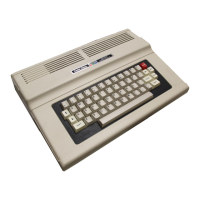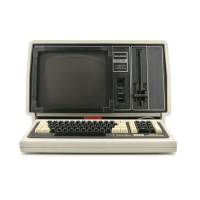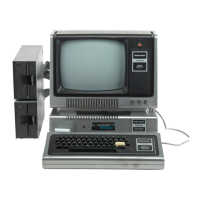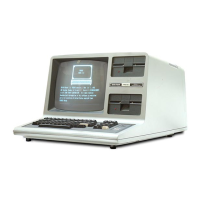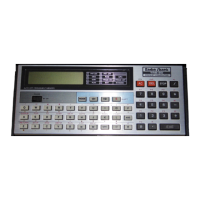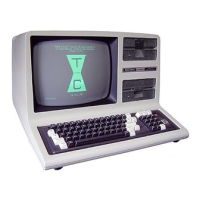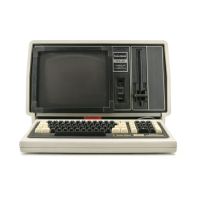binary
11,
Z66 will output a very
narrow pulse which
clears
Z32 back to
zero. The 60 Hz at pin 1 1 is
used by the sync
generator
circuits
to
produce the
vertical
sync
for the
monitor.
VIDEO RAM
ADDRESSING
During our
discussion of the system
block diagram,
you
noticed that the video
RAMs must be addressed
from two
sections.
The CPU must address video
RAMs
to
read or
write data
from or to specific
locations. The divider
chain
must
also address
video RAM
so
that data
contained in
memory can be
processed and
displayed
on the
screen. The
video RAMs are
addressed either by the
CPU or by the
divider chain through
the use of three
multiplexers.
Z64, Z49 and Z31 are the
three multiplexers used
for video
RAM addressing.
From
the
divider chain, there are 10
address
lines that will
be
used to
address video
RAM. The
chain
conditioning
logic supplies one address
—
C1. Z65
supplies three addresses
-
R1, C2 and
C4. Z50 supplies
three
addresses
-
C8,
C16 and C32. Z32
supplies the rest
-
R2, R4 and R8.
Imagine an array
of rectangles; 16
rec-
tangles
vertically and 64 rectangles
horizontally.
You would
have
a
total of 1024
rectangles.
You
could
specify
any
one
rectangle
by
saying,
"Starting at the
top left
hand corner, go
down
four
rows
and go to
the right 18 columns."
The 16
rows could
be assigned a binary
number from to 15.
The
64 columns could be
assigned a binary
number from
to
63. Rectangle
0—0
would be in the
upper left hand
corner of the array.
Rectangle
15—63
would be in the lower
right hand
corner.
Four bits of binary information
would
therefore specify any
one of the 16
rows. It takes six
bits
of binary data to
specify any one of the
64 columns. This is
exactly
the
addressing format
used by the
counter chain.
C1, C2, C4, C8,
C16
and
C32 specify
any column. R1,
R2,
R4 and
R8 specify a row.
The row/column addressing
for-
mat
is very useful in
troubleshooting video
problems in the
TRS-80.
The column and row
address outputs
from the divider
chain
are
applied
to
the
"1
" inputs of the
multiplexer.
Part
of the
CPU's address bus is
tied to the
"0"
input of the
multi-
plexer.
The outputs
of the
multiplexer are tied to the
video
RAMs or
logic
around them. We've
got inputs and
outputs;
how
about control?
Do you
remember the signal
VID* that
we generated
back in the
address
decoding discussion?
We
said
VID* will select
the video
RAMs. Notice that pin 1 of
the
3
multiplexers is tied to
VID*. When the
CPU
wants
control over the
video
RAM, the address
decoder recognizes
the video
RAM
address and
causes
VID*
to go
low. When
VID*
is
low, the
multiplexer
switches the
"0"
inputs over
to the
multiplexer
outputs.
The counter
chain addresses are
switched out
of the
circuit, and the
CPU has control
over
video
RAM. When
VID* goes back
high, the
CPU
is
switch-
ed out
and the
counter chain
takes over.
Most
of
the time,
the counter
chain is
in control
of video RAM. The
CPU
only takes
charge
when it needs
to.
You
can
see on the
display screen
when the
CPU
robs
the counter
chain of
video
RAM
control.
Ever notice black streaks
all over the
screen
while
graphics are being drawn?
These streaks
are the
result of
the counter
chain
losing control over
video
RAM.
Aside from
chain and
CPU address,
there are
inputs to the
multiplexer we
have not
yet mentioned.
The first
of these
inputs
is the resistor
at pins
13 and 6 of
Z49. These two
inputs,
which are not
needed in the
counter chain's
control
over
video
RAM,
are
pulled up
to 5 volts by
R49. Output
pins
12 and
7 correspond to
the inputs at pins
13 and 6.
When the
chain has
control over video
RAM,
pinsJI2
and
7
output
a steady state high.
Pin
12
goes to the R/W (Read/
Write)
control of
all the
RAMs. Since the
counter chain
never stores
data in
RAM at the
address it
specifies, pin 12
should be
high when
the chain
is in control.
Pin
7
of
Z49
goes to the
video
RAM data buffer.
When the
chain is in
control, the
RAM data
bus should
be disabled. A
high on
VRD*
(Video Read)
guarantees
this bus
will be off.
We
also find WR* and
RD* tied to
pins 14 and 5
of Z49.
When the
CPU
takes
charge of
the video
RAMs, multiplexer
output at
pin 12
becomes
VWR* (Video Write).
The
CPU
can
store data into the
video
RAMs by causing
VWR* to go
low. If the
CPU
wants
to read data
from video
RAMs, RD*
can pass
through Z49 and
activate
VRD*. A low here
will
open data
buffers Z60 and
Z44. Addressed video
RAM
data
is then placed
on the data bus.
The
CPU
can process this
data like any other
data.
ALPHANUMERIC FORMAT
The CRT
(Cathode Ray Tube)
in the
display
will be scanned
twice
per second. The
electronic beam
in
the CRT
travels
from top to bottom
of the screen and
left to right.
Each
screen or frame
consists of 264 scan lines.
192
scan
lines
are used in the "picture".
72 lines are used
during
vertical
interval and as upper
and lower boundaries.
Nothing
is
ever
"written"
or
visible
within
these 72 lines.
There are 1024
character
locations
per
screen (or 512,
depending on
status
of
MODESEL). Each character line consists
of 64
charac-
ters (or
32,
depending on the status
of
MODESEL). There
are
16 character lines. Each
character line consists of
12
scan
lines. An alphanumeric
character uses seven
scan lines
while there are five blank scan
lines between
character lines.
We'll worry
about graphics
formatting later.
Part of Z65
and
Z50 specify
the column address.
Z32 speci-
fies the row (or
character line).
Z12 specifies the
scan line
in any
character line. The outputs from
Z12 are labeled
L1,
L2, L4 and L8.
These four lines are not
used in video
RAM
addressing
because
we
already stated a
row and column
address will specify any one
of the 1024
rectangles in
our
rectangle array.
Z12's outputs are used in
the video proces-
sing. L1, L2, and
L4 will enable the
character generator to
output correct data for any
character since it knows
where
the
CRT's electron beam is scanning.
L8 is used
by the
video
processor
to
blank (turn
off) the five
lines between
character lines.
16
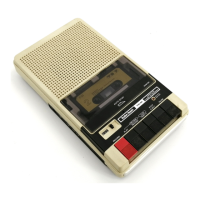
